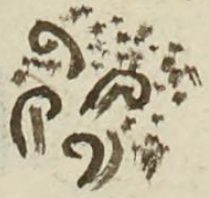Tlaltetecuin (MH662r)
This black-line drawing of the simplex glyph for the personal name Tlaltetecuin (a deity name, “Earth Stomper”) is attested here as a man’s name. The glyph shows at least four speech scrolls or volutes, perhaps suggesting the sound made by the deity as he stomped the earth (tlalli). The verb tecuini relates to pounding, and it is reduplicated here, perhaps as an intensifier or to say pounding here and there. Mixed in with the scrolls are dots, like dust (teuhtli), which can be associated with a deity (Teuhcatl), but perhaps they are actually meant here as tlalli (earth, land).
Stephanie Wood
Tlaltetecuin and Ixtlilton were related deities associated with medicine and dances that bring health, but also the communication between humans and the divine world. For more information, see Katarzyna Mikulska, Tejiendo Destinos (2015). Might earth pounding have something to do with earthquakes? Or might an Earth stomper be a dancer? Or perhaps one who is tamping down the ground after seeding it? Assistance with the interpretation of this glyph and the deity name would be appreciated.
Stephanie Wood
1560
Jeff Haskett-Wood
trono, tronar, pisotear, golpear, nombres de deidades, nombres de hombres

Tlaltetecuin, deity name, another name for Ixtlilton, https://nahuatl.wired-humanities.org/content/tlaltetecuin
tecuini, for one’s heart to pound, https://nahuatl.wired-humanities.org/content/tecuini
tetecuitza, to stomp, https://nahuatl.wired-humanities.org/content/tetecuitza
tlal(li), land, https://nahuatl.wired-humanities.org/content/tlalli
Pisotea la Tierra
Stephanie Wood
Matrícula de Huexotzinco, folio 662r, World Digital Library, https://www.loc.gov/resource/gdcwdl.wdl_15282/?sp=404&st=image.
This manuscript is hosted by the Library of Congress and the World Digital Library; used here with the Creative Commons, “Attribution-NonCommercial-ShareAlike 3.0 License” (CC-BY-NC-SAq 3.0).









